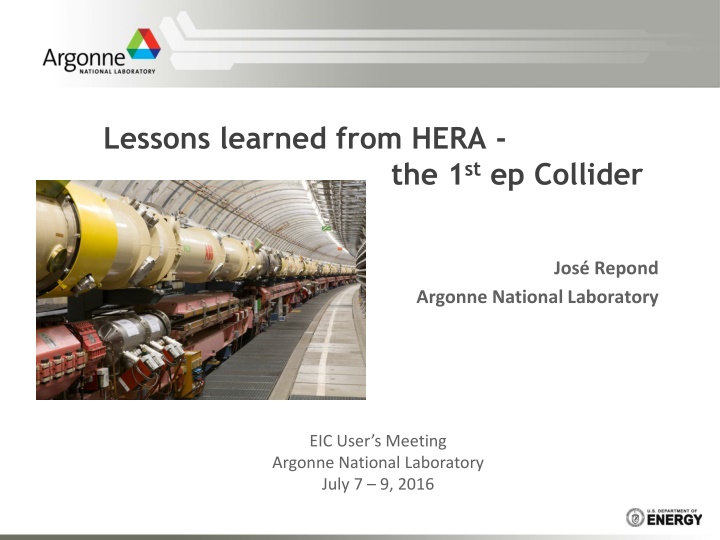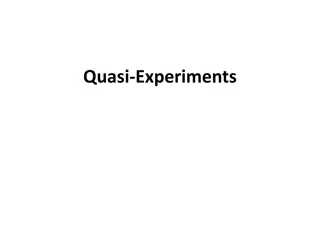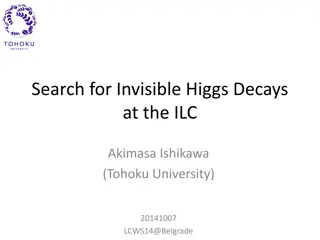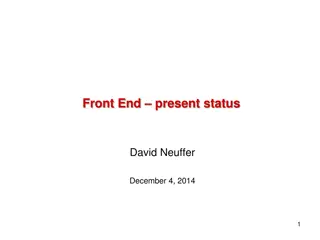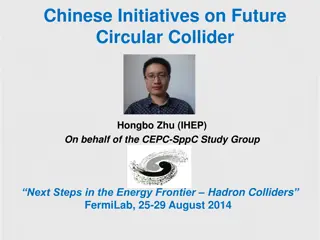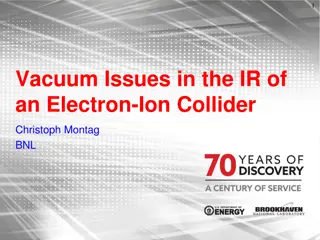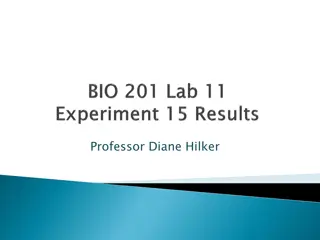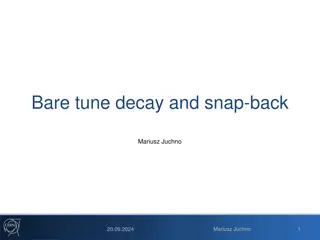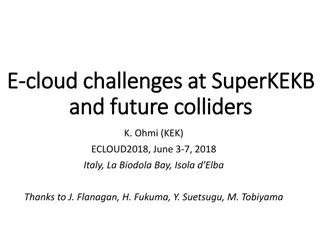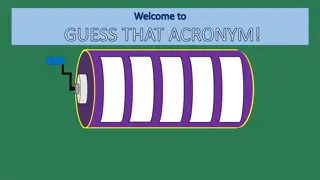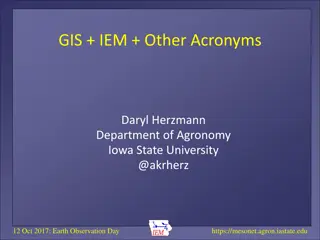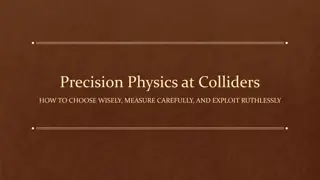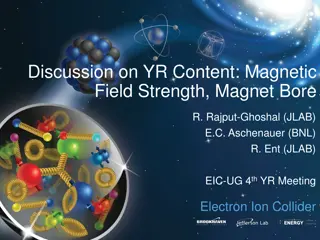Insights from HERA Collider Experiments and Acronyms
Lessons learned from the HERA collider regarding its operation, detectors, experiments, and challenges faced. Acronyms like HERA, H1, ZEUS are explained, along with details on beam collisions and detectors used. Personal insights and caveats shared by a researcher who was involved in the HERA project are also included.
Download Presentation

Please find below an Image/Link to download the presentation.
The content on the website is provided AS IS for your information and personal use only. It may not be sold, licensed, or shared on other websites without obtaining consent from the author.If you encounter any issues during the download, it is possible that the publisher has removed the file from their server.
You are allowed to download the files provided on this website for personal or commercial use, subject to the condition that they are used lawfully. All files are the property of their respective owners.
The content on the website is provided AS IS for your information and personal use only. It may not be sold, licensed, or shared on other websites without obtaining consent from the author.
E N D
Presentation Transcript
Lessons learned from HERA - the 1step Collider Jos Repond Argonne National Laboratory EIC User s Meeting Argonne National Laboratory July 7 9, 2016
A quick reminder: What was HERA? The one and only ep Collider (so far) Electron/positron beam of 27.5 GeV Proton beam of 820 920 GeV Center of mass energy s = 300 318 GeV Location Deutsches Elektronen Synchrotron DESY, Hamburg, Germany Operation Started in 1992 (exactly on time!), ended in 2007 Experiments Collisions: H1 and ZEUS Electrons/positrons and gas jet target (polarized): HERMES Protons and wire target: HERA-B 3
The Colliding Beam Experiments: Multi-purpose 4 detector with Charged particle tracking Si - VTX Central drift chamber Liquid Argon calorimeter 12 E % GeV % GeV em= E ( 50 E ) had= E ( ) Rear Pb-scintillator plug 5 . 7 E % em= E ( ) GeV Muon chambers and more 4
The Colliding Beam Experiments: Multi-purpose 4 detector with Charged particle tracking Si - VTX Central drift chamber Uranium-Scintillator calorimeter 18 E % GeV % GeV em= E ( 35 E ) had= E ( ) Muon chambers and more Note: both detectors are asymmetric around the interaction point 5
Acronyms HERA Hadron-Elektron Ring Anlage H1 First experiment at HERA H2 ZEUS Zero Experience with Uranium - Scintillator 6
Lessons learned from HERA Caveats This is my personal view I am/was more familiar with ZEUS, H1 was just as good It s been a long time some details might not be accurate 7
ZEUS Phys Lett B 303(1993)183 HERA was a complex/difficult collider HERA contained 2 machines An electron machine A proton machine Need to collide the 2 beams Without Backgrounds Electrons radiate synchrotron radiation Radiation deteriorates the vacuum Protons interact with gas beam-gas events With timing cuts Useful variable = 2 = = (E - p ) GeV 55 E For DIS events z e beam all particles (losses down the forward beam pine give a negligible loss) Precise timing is important 8
Slow Start-up of HERA H1, ZEUS detectors Designed for High-Q2 physics The hope was to discover Lepto-quarks DIS cross-section High Q2 requires high luminosity Photoproduction Real photons: Q2 ~ 0 Study came as an afterthought, while waiting for the luminosity to improve Design your detector to measure/do everything 9
Luminosity upgrade HERA I CY 1992 2000 Integrated luminosity 193 pb-1 Machine upgrade CY 2000 2002 Decreasing proton beam size Decrease electron beam size (move quadrupoles closer and increase their strength) HERA II CY 2002 2007 Serious problems with synchrotron radiation/shields Integrated luminosity 586 pb-1 Not all upgrades are worthwhile 10
ZEUS Trigger System Bunch crossings Every 96 ns The 3-level trigger system of ZEUS - First level Data stored in 5 microsecond pipeline, clocked at 96 ns Reduction from 100 kHz to 1 kHz - Second level Microprocessors analyze digitized data Reduction from 1 kHz to 100 Hz - Third level Full event building Analyzed by computer farm Reduction from 100 Hz to 10 Hz Invented by ZEUS and now being used at the LHC 11
Expect the unexpected: Diffraction Normal low-Q2 DIS event Low-Q2 DIS event w/out p-remnant Events without proton remnant About 10% of all DIS events: totally unexpected! Several methods to identify/measure Rapidity gap, MX, leading proton detection Precision measurements Diffractive structure functions 12
Expect the unexpected: Gluons at low-x Pre-HERA knowledge of F2 Limited to x > 5 10-2 Low x behavior totally unknown Precise measurements at HERA Pinned down low-x behavior Spectacular increase of gluon density at low-x Perhaps the most important result from HERA 13
Jet Physics: Infrared safe jet algorithms Hadronic jets At collider energies, hadrons tend to cluster in jets Jets reflect physics of underlying hard (parton) scattering Various algorithms to define jets Pre-HERA Jet-physics at the colliders of the day (Tevatron,SppS, LEP, PEP, PETRA ) Use of so-called Cone Algorithm Group all particles together within a certain cone in - space Major disadvantage Algorithm not infrared safe, i.e. soft and collinear divergencies do not cancel Problem for theoretical calculations Introduction of unphysical Rsep parameter Precise comparison with theory impossible 14
Jet Physics: Infrared safe jet algorithms kt Algorithms Infrared safe (divergencies cancel) Distance measures 2 ij R 2 T 2 T min( , ) d p p , , ij i j 2 R = + 2 ij 2 2 ( ) ( ) R = y y i j i j R jet radius 2 T d p , iB i Systematic studies by H1 and ZEUS Comparison with fixed order NLO calculations Precision jet physics is possible + . 0 + = 0023 . 0 0022 . 0 0042 0035 . 0 ( ) 1206 . 0 (exp .) ( .) MZ th S 15
Forward detectors are challenging Initial design 3 disk-like chambers Drift cells with fixed wire orientations Problems with occupancy! Straw Tube Tracker Implemented in 2001 Straws running tangentially to beam pipe solved occupancy problem Possibly first fully functional forward tracker in a colliding beam experiment 16
H1 versus ZEUS Optimized for hadronic measurement: 35%/ E Optimized for electron measurement: 12%/ E Physics reach? Despite different detector philosophy, comparable physics reach 17
Combined H1 and ZEUS Results 7 combined papers since 2009 - Multi-Leptons with High Transverse Momentum - Events with an Isolated Lepton and Missing Transverse Momentum - Combined Measurement and QCD Analysis of the Inclusive e+p - Combined Inclusive Diffractive Cross Sections - Combination and QCD Analysis of Charm Production Cross Section - Combination of Differential D*+ Cross-Section Measurements in - Combination of Measurements of Inclusive Deep Inelastic Scattering Useful to have 2 detectors with different systematic uncertainties: 1 + 1 > 2 18
Commensurate Theory Effort Needed Cost HERA accelerator ~ $1B HERA experiments ~ $0.5B 1 theorist <$0.0005B/year Precision measurements Diffraction Jet production . Theoretical calculations Lower precision Often limiting factor 19
Conclusion 20
